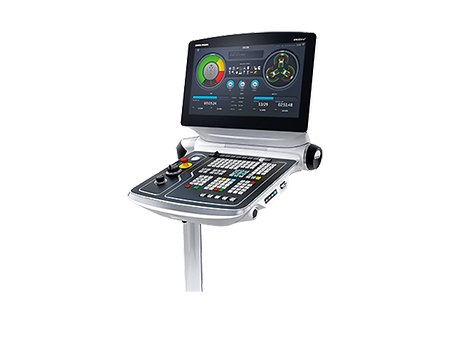


LASERTEC PowerDrill: Laser Drilling Machines
Laser machining centers for 5-axis laser drilling
- 5-axis laser precision drilling of turbine blades / vanes and other components for aerospace / IGT
- PowerShape technology for shaped hole geometries
- Special developed LASERSOFT PowerDrill Softwarefeatures
- Technology leader in 5-axis laser drilling
- CELOS: The app based control and operating system
- Exclusive DMG MORI technology cycles available
- ERGOline 21.5" Multi Touch Panel with CELOS and SIEMENS SINUMERIK 840 D sl
The leader in 5-axis laser-drilling technology
Through close collaboration with leading manufacturers of aerospace components and stationary gas turbines, DMG MORI has built up huge expertise in the development and application of laser drilling. This has established the leading machine tool manufacturer as a technology leader in 5-axis laser drilling, resulting in a product range that excels in industrial series production, especially when it comes to the LASERTEC PowerDrill series.
Wear-free processes with maximum precision
Guide vanes and rotor blades, combustion chambers as well as other essential components in aircraft or stationary gas turbines possess numerous air holes for cooling. Laser drilling with LASERTEC PowerDrill machines is a noncontact process. This means that a high-performance laser is directed onto the surface of the workpiece, where the energy of the laser beam melts and vaporizes the material, creating a hole. Various strategies are available: With percussion drilling, the material is processed with a succession of several short laser pulses. This method allows for the ultra-high-precision creation of deeper holes while using less energy. This even makes micro-drilling possible, with tiny diameters down to 0.05 mm. Trepanning enlarges an existing starter hole by guiding the laser in circular paths over the component. Laser drilling is substantially faster than conventional, mechanical drilling methods—the former is capable of up to 500 bores per second with a rotating workpiece, and it does so wear-free.
The right machine solutions for every application
With the LASERTEC 50 PowerDrill and the LASERTEC 100 / 160 PowerDrill, DMG MORI delivers a wide range of components for five-axis laser precision drilling, from small parts to XXL components. The travel distances are 540 × 500 × 700 mm and 1,600 × 1,000 × 1,000 mm, respectively. The positioning accuracy of the machines is 9 µm. Fiber lasers are used as laser sources and boast peak powers ranging from 9 kW to 23 kW. The PowerShape technology allows for shaped hole geometries. To deliver convenient operation and programming, DMG MORI has also developed the LASERSOFT PowerDrill software.
Automation solutions mean that laser technology can be used even more productively. By using pallet handling systems, users can optimize their deployment of LASERTEC PowerDrill machines even during unmanned shifts. Both technologies, PowerDrill and PowerShape, can even be effectively integrated alongside one another.
Laser drilling: a quick summary
How does laser drilling work?
With noncontact laser drilling, a high-power laser is directed onto the surface of a material. The energy from the laser beam melts and vaporizes the material right on the spot. The resulting vapor pressure is high enough to expel the melted material from the drill hole.
What is percussion drilling?
While laser drilling in its simplest form rapidly creates many holes with very high pulse energy, percussion drilling is a gentler process that uses less energy. This involves several shorter laser pulses in succession. This method creates deep, precise holes.
What is trepanning?
Trepanning enlarges an existing starter hole. The laser beam moves in circular paths over the workpiece. During this process, the molten material is mostly driven downwards out of the drill hole.

